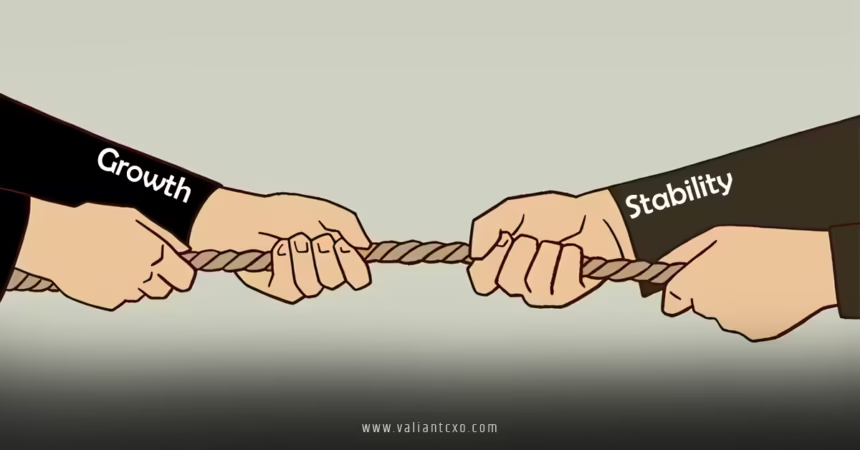The Tug of War Between Growth and Stability is a universal struggle, whether you’re running a business, managing personal finances, or even navigating life’s big decisions. It’s like trying to walk a tightrope while juggling flaming torches—one wrong move, and you’re either stagnating or crashing. Growth pushes you to take risks, innovate, and chase big dreams, but stability whispers, “Hey, don’t lose what you’ve already got.” How do you balance the two without toppling over? In this article, we’ll dive deep into the tension between these forces, exploring why The Tug of War Between Growth and Stability matters, how it plays out in different contexts, and practical ways to find harmony. Buckle up—it’s going to be a wild ride!
Understanding The Tug of War Between Growth and Stability
What Does Growth Mean?
Growth is the spark that fuels progress. It’s about expanding—whether that’s scaling a business, boosting your savings, or leveling up your skills. Picture a sapling stretching toward the sun, reaching for more light, more space, more potential. In business, growth might mean launching a new product or entering a new market. Personally, it could be learning a new skill or chasing a bold career move. But here’s the catch: growth often demands risk. You’re stepping into the unknown, betting on a future that’s not guaranteed. Exciting? Absolutely. Terrifying? Sometimes.
What Does Stability Mean?
Stability, on the other hand, is your anchor. It’s the comfort of knowing your bills are paid, your job is secure, or your business is humming along without drama. Think of it as a cozy house during a storm—safe, predictable, and dependable. Stability prioritizes consistency over flashy wins. It’s about maintaining what works, avoiding unnecessary risks, and ensuring you’ve got a safety net. But lean too hard into stability, and you might end up stuck, watching opportunities pass you by.
Why The Tug of War Between Growth and Stability Exists
Why can’t we just have both? Well, The Tug of War Between Growth and Stability exists because resources—time, money, energy—are finite. Pour all your cash into a risky new venture, and you might jeopardize your stable foundation. Stick to the safe path, and you could miss out on game-changing opportunities. It’s a constant push and pull, like two kids fighting over the last slice of pizza. Each side has its merits, but neither can dominate without consequences.
The Tug of War in Business: Scaling vs. Securing
Growth in Business: Chasing the Next Big Thing
In the business world, The Tug of War Between Growth and Stability is front and center. Growth often means chasing bold moves—think expanding into new markets, launching innovative products, or hiring a bigger team. Take a company like Tesla. They’ve bet big on electric vehicles and renewable energy, pouring billions into R&D and global expansion. The result? Explosive growth, but also plenty of sleepless nights for investors. Growth requires optimism, vision, and a willingness to embrace uncertainty.
Stability in Business: Holding the Fort
On the flip side, stability in business is about protecting what you’ve built. It’s ensuring cash flow, maintaining customer trust, and avoiding overextension. A small family-owned bakery, for example, might focus on keeping its loyal customer base happy rather than opening ten new locations. Stability means saying “no” to shiny opportunities that could stretch resources too thin. It’s less glamorous but keeps the lights on. The Tug of War Between Growth and Stability forces businesses to decide: do you double down on what’s working, or roll the dice on something new?
Striking a Balance in Business
So, how do businesses navigate The Tug of War Between Growth and Stability? The key is strategic pacing. Consider a hybrid approach: allocate a portion of resources to innovation while safeguarding core operations. For instance, Google invests in moonshot projects like self-driving cars through its “X” division, but its bread-and-butter search engine keeps the revenue flowing. Data backs this up—a Harvard Business Review study found that companies balancing innovation with operational efficiency tend to outperform those chasing growth at all costs. It’s about knowing when to sprint and when to stroll.
The Tug of War in Personal Finance: Risk vs. Reward
Growth in Personal Finance: Building Wealth
When it comes to your wallet, The Tug of War Between Growth and Stability is a daily reality. Growth in personal finance means investing in stocks, starting a side hustle, or diving into real estate. It’s about making your money work harder, even if it means risking some losses. Imagine planting a seed—you hope it grows into a mighty oak, but a storm could wipe it out. For example, investing in a diversified stock portfolio might yield 7-10% annual returns over time, but market dips can test your nerves.
Stability in Personal Finance: Securing Your Future
Stability, on the other hand, is about protecting your financial foundation. It’s keeping an emergency fund, paying off debt, or sticking to low-risk investments like bonds or savings accounts. Stability feels like a warm blanket—safe but not exactly thrilling. For instance, keeping six months’ worth of expenses in a high-yield savings account ensures you’re covered for unexpected emergencies, but it won’t make you rich. The Tug of War Between Growth and Stability forces you to decide: how much risk can you stomach?
Finding Financial Harmony
Balancing The Tug of War Between Growth and Stability in personal finance requires a clear plan. A common strategy is the 50/30/20 budgeting rule: 50% of income for necessities, 30% for wants, and 20% for savings and investments. Within that 20%, you might split your efforts—say, 10% in stable options like bonds and 10% in growth-oriented investments like stocks. This way, you’re building wealth without betting the farm. Tools like compound interest calculators can help you visualize how small, consistent investments grow over time.
The Tug of War in Personal Life: Adventure vs. Comfort
Growth in Personal Life: Chasing Dreams
Outside of work and money, The Tug of War Between Growth and Stability shapes your personal life too. Growth means chasing big dreams—moving to a new city, switching careers, or starting a family. It’s exhilarating but risky. Imagine quitting your stable job to travel the world or launch a passion project. The potential rewards are huge, but so are the unknowns. Growth asks, “What could you become if you took a leap?”
Stability in Personal Life: Finding Peace
Stability, meanwhile, is about routine and comfort. It’s staying in a familiar town, sticking with a steady job, or prioritizing family traditions. Stability feels like coming home to your favorite couch after a long day—reassuring and predictable. But lean too far into comfort, and you might wonder, “What if I’d taken that chance?” The Tug of War Between Growth and Stability challenges you to weigh adventure against security.
Balancing Personal Growth and Stability
Finding balance here is deeply personal. One approach is to take calculated risks—small steps toward growth that don’t upend your life. For example, if you’re itching to switch careers, try taking night classes or freelancing on the side before quitting your day job. This way, you’re dipping your toes into growth while keeping one foot in stability. Reflecting on your values—what matters most to you?—can guide these decisions. Journaling or talking with a trusted friend can help clarify where you stand in The Tug of War Between Growth and Stability.
Strategies to Win The Tug of War Between Growth and Stability
Set Clear Goals
To navigate The Tug of War Between Growth and Stability, start with clear goals. What does growth look like for you? Is it a promotion, a new skill, or financial independence? What does stability mean—security, peace of mind, or a steady routine? Write down specific, measurable goals for both. For example, “Save $10,000 for an emergency fund” (stability) and “Invest $5,000 in a stock portfolio” (growth). Clear goals help you allocate resources without losing sight of either side.
Embrace Incremental Progress
You don’t have to choose between growth and stability—think of them as dance partners, not rivals. Small, consistent steps can move you toward both. In business, test a new product in a single market before going all-in. In personal finance, automate savings while gradually increasing your investment contributions. Incremental progress reduces risk while keeping you on the path to growth. It’s like climbing a mountain—one step at a time gets you to the peak without falling off.
Build a Safety Net
A strong safety net makes growth less scary. In business, this might mean maintaining a cash reserve to weather unexpected challenges. Personally, it’s an emergency fund or a supportive network of friends and family. Knowing you’ve got a fallback allows you to take calculated risks. The Tug of War Between Growth and Stability feels less daunting when you know you’ve got a parachute.
Stay Flexible
The Tug of War Between Growth and Stability isn’t static—it shifts with time and circumstances. What feels stable today might not tomorrow. Stay open to reassessing your priorities. Maybe you lean into growth during your 20s, chasing career opportunities, then prioritize stability in your 30s as you start a family. Flexibility lets you adapt without losing balance.
Conclusion: Mastering The Tug of War Between Growth and Stability
The Tug of War Between Growth and Stability is a lifelong balancing act. Whether in business, finance, or personal life, the tension between chasing ambition and securing what you have shapes your decisions. There’s no one-size-fits-all answer, but by setting clear goals, embracing incremental progress, building a safety net, and staying flexible, you can find harmony. The key is to keep both sides in view—growth fuels your dreams, while stability keeps you grounded. So, take a deep breath, step onto the tightrope, and start walking. You’ve got this!
FAQs About The Tug of War Between Growth and Stability
1. Why is The Tug of War Between Growth and Stability so challenging?
The Tug of War Between Growth and Stability is tough because it pits risk against security. Growth requires stepping into the unknown, while stability demands protecting what you have. Balancing both means making tough choices with limited resources, which can feel like a high-stakes game.
2. How can businesses manage The Tug of War Between Growth and Stability?
Businesses can manage The Tug of War Between Growth and Stability by allocating resources strategically—investing in innovation while maintaining core operations. For example, testing new products in small markets or keeping a cash reserve can balance risk and security.
3. What’s a practical way to balance growth and stability in personal finance?
A practical approach is diversifying your financial strategy. Split your savings between stable options like bonds and growth-oriented investments like stocks. Following a budgeting rule, like 50/30/20, helps you cover necessities while pursuing wealth-building.
4. Can The Tug of War Between Growth and Stability apply to personal relationships?
Absolutely! In relationships, growth might mean taking risks like moving in together or starting a family, while stability focuses on maintaining trust and routine. Balancing both involves open communication and aligning on shared goals.
5. How do I know if I’m prioritizing growth or stability too much?
If you’re constantly stressed about risks, you might be overemphasizing growth. If you feel stuck or uninspired, stability might be holding you back. Reflect on your goals and assess whether your choices align with both sides of The Tug of War Between Growth and Stability.
Click Here:valiantcxo.com


